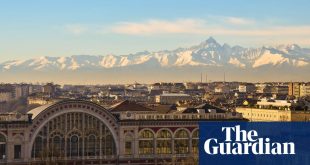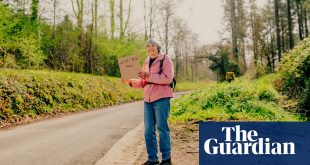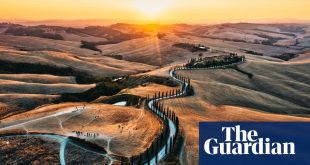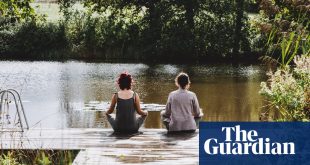Zagori, Pindus mountains
The Zagori region, in the remote north-west of mainland Greece, is dominated by the lush Pindus mountains, home to alpine lakes, the world’s deepest gorge and pristine river pools. The area is also famed for its mountain villages, or Zagorochoria, built around splendid plane-tree-lined squares and connected via cobbled trading tracks and Ottoman bridges.
Konitsa, in the north of the region, has one of the finest of these bridges, completed in 1870 to span the Aoos River. Locals frolic in aquamarine water beneath a hanging bell that warns of winds strong enough to endanger those crossing.
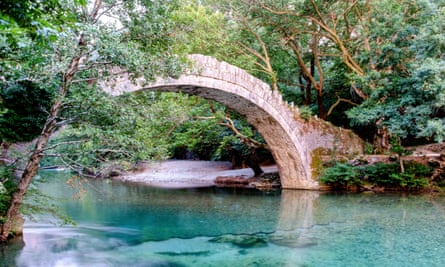
But the best base is Papingo, a 45-minute drive further into the mountains, great for exploring Zagori’s spectacular central artery: Vikos gorge – among the world’s deepest – is 1,000 metres deep in places. It’s south-west of Vikos, between sheer limestone walls sheltering a series of revitalising springs and pools perfect for jumping and diving into. Alternatively, the exhilaratingly cold Papingo rock pools lie beneath towering cliffs a little to the north-east.
At the ivy-clad Saxonis Houses (doubles from €90 B&B) in Papingo, the owner, Vasilis, can arrange mountain activities. Salvia restaurant has sweeping vistas and refined dishes rooted in local traditions, including mouthwatering baklava.
Southern Zagori offers an even more hair-raising perspective. From frescoed Agia Paraskevi monastery, a precipitous ledge offers views back down into the Vikos gorge. The nearby Vradeto Steps are a steep ancient staircase hewn into a cliff – the only way into or out of Vradeto until the 1970s. In neighbouring Kapesovo, Thoukididis’s menu brims with ingredients either homegrown or foraged from local hillsides. A little further west, Rokka Guesthouse (doubles €70 B&B) offers loom workshops, farm tours and homemade food with fruit, vegetables, nuts and seeds from the surrounding land.
Zagori’s real wildness is found at its mythical Drakolimnes, or dragon lakes, named after duelling dragons that supposedly once roamed local peaks. Old mule tracks crisscross a landscape of forested ravines and snow-capped crags – a hiker’s dream. Astraka Refuge, accessible by hiking the 03 route from Papingo, makes a rustic but comfortable base camp, perched at 1,950 metres between the peaks of Astraka and Tymfi. Its 51 bunks (€18 a night) are available from May to October. Tymfi Dragon Lake, a mountaintop bowl cradled amid dramatic summits, is best viewed at sunrise, while keeping an eye out for brown bears and golden eagles.
Ithaca, Ionian Islands

Ithaca is the smaller and less-visited sister island to Kefalonia, a mile or so to its east. Essentially two islets connected by the vertiginous Isthmus of Aetos, it’s a surprisingly lush green oasis of wide-open vistas and secret coves. It’s also the home to which Homer’s Odysseus returned after 20 years, and its history includes rule by Rome, the Byzantine empire, Venice, the French and the British – so it is rich with poignant historic relics.
Afales beach is the jewel in Ithaca’s northern crown. Its pristine sands beneath white cliffs can be reached by boat – and it makes an unforgettable sunset location or wild campsite. Four miles to the south, near Kioni port, Villa Votsalo (sleeps four, from €142 a night, three-night minimum) has amazing sea views from its four furnished terraces.
Nearby Myrtia is northern Ithaca’s choice restaurant, a stroll from what are believed to be the ruins of Odysseus’s palace. It serves thoughtful interpretations of traditional island dishes with hyper-local or homegrown ingredients and overlooks the sea.
For southern Ithaca, the small harbour town of Vathy is an ideal base for exploring. Twin iron cannons, once a Venetian deterrent, sit silently among fragrant pines overlooking the bay’s entrance. From here, a coastal footpath leads to St Andrew chapel, greeting seaborne port traffic. South of town is Rizes cave, where a narrow entry leads through to a huge round cavern with a great opening in the roof shaded by a twisted canopy of trees. Some say Eumaeus, Odysseus’s swineherd, unknowingly gave shelter to his disguised king here. There are many sandy beaches to choose from too. Gidaki beach is arguably the pick, a vast curve of shells and quartz reached by a beautiful coastal walk. Or there are beanbags under parasols and a seasonal bar on Kaminia beach.
Off-grid Filiatro Tiny House (£56 a night for two) is a charming outpost. The host, Rolf, built it on a hillside using largely upcycled materials. It has a compost toilet, no air conditioning and two rustic floors opening to a wooden balcony with quiet sea views.
Evia
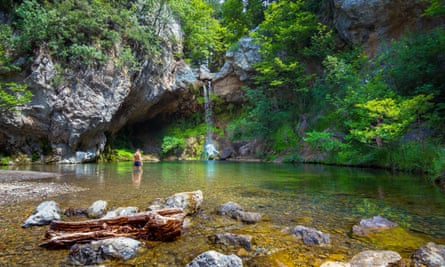
Greece’s second-largest island is only an hour’s drive from Athens (via a long road bridge) yet its coast, alpine heights, verdant gorges and spring-fed waterfalls are little known to tourists.
Mount Dirfi, the island’s highest peak, dominates the north. In its foothills, Nileas gorge teems with wildlife and fauna, and nearby Drymonas waterfall cascades from a curved overhang into an enticing forest pool. Family-run Vriniotis is the pick of Evia’s wineries, on a hillside overlooking the North Euboean Gulf. And Lavender Farm Cottage (sleeps six, from €160 a night) is an ivy-tangled, pastel-pink house with a bountiful garden. There’s a rolling pool-to-sea view, and fresh eggs every morning.
Central Evia’s beaches are one of Greece’s best-kept secrets, especially around Kymi. Damianos is one of several pebble strands between green headlands and popular with naturists and long-term campers. Thapsa beach has a Shangri-la feel, splendid sunsets and is dotted with rocky nooks for campers. For a larger group of non-campers, Seta River House (sleeps 16, from €240 a night) is a fairytale abode in a forest of fir and cherry trees. Host Giannis can organise mushroom walks, music evenings and open-air film nights. There’s craft beer at Septem microbrewery, and Marditsa restaurant, on a hill above Limnionas beach, uses homegrown ingredients to make a mutton burger to die for.
Southern Evia is dotted with mysterious drakóspita, or dragon houses: ancient hilltop buildings with uniquely corbelled roofs, their purpose and origin unknown. Made with unmortared limestone slabs they are so impressive it’s said dragons must have built them. Mount Ochi’s summit claims arguably the island’s finest, though the Styra Dragon Houses below are more accessible.
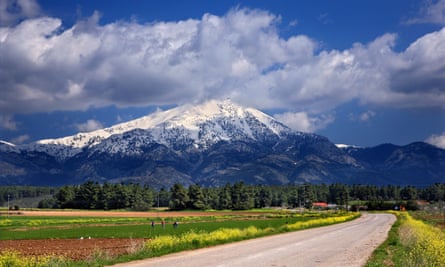
Nearby is Armena Castle, a ruined fortress, which affords great views of the island and mainland; and Dimosari gorge, just north of Mount Ochi, offers seasonal swimming and year-round walking amid abundant wildlife and fossils.
In the far south-east, Archampoli may be the best beach on Evia: unfurling from a gorge mouth beneath sheer cliffs reached by a wild coastal trail, it warrants a full day out. An hour’s drive away on a hill above Karystos on the south coast, O Platanos Karystinakis does superb homemade cheeses and fire-cooked meats (fittingly for an island derived from the words “good” and “ox”).
Mani, Peloponnese
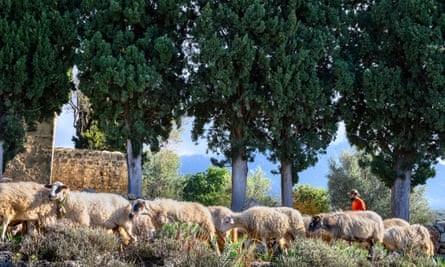
Mainland Greece’s most southerly tip, the Mani peninsula, sits between the Laconian and Messenian gulfs south of the Peloponnese. The Maniots were descended from the Spartans and the last Greeks to convert to Christianity. The area maintained a degree of autonomy throughout Greece’s long history of occupation. Dominated by the Taygetos mountains and hundreds of fortified villages, the Mani remained inaccessible to most visitors until roads were built in the second half of the 20th century and, to this day, travel here is rugged but rewarding.
after newsletter promotion
The north-western coast is a string of coastal gems, centred on relaxed Kardamili, where villagers and tourists swim off paved rock ledges in the crystal waters of Gnospi.
Further south, at Kataphygi rocks, an ancient river cavern has shaped marble-limestone formations into fantastical shapes, creating a unique amphitheatre for sunbathing, cliff-jumping, and swimming. The mouth of the cave above is huge and twists two miles underground. Ducking and crawling through the first 100 metres of its slippery dark passages is thrilling, though inhabited by thousands of (harmless) spider crickets. Appropriate clothing and a torch are recommended.
Diane’s Yurt (£62 a night for two), in a terraced garden of olive trees above the sea, offers sanctuary just north of Kardamili. The former home of Patrick and Joan Leigh Fermor is also available from June to September as a holiday let sleeping 10 (at the very steep price of €5,406 a night). But those with smaller budgets can still visit the museum dedicated to the travel writer whose book Mani is a poetic ode to the region’s history and culture.
Kardamili’s two standout restaurants – the shady grove and bougainvillea at Elies, or the slightly more gourmet Lela’s Taverna – are both managed by sons of the Fermors’ former housekeeper, Lela.
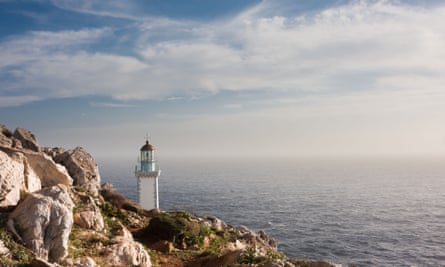
Mani grows scrubbier further south. The ruins of Tigani castle and its Byzantine remains stand on a lonely, wild peninsula, and nearby, Odigitria church, also Byzantine, is one of Greece’s most aesthetic and ascetic churches, built into a hidden bluff above a steep slope rolling down to the sea. Both are stunning at sunset.
Near the village of Koita, hotel Città dei Nicliani is in a designated ancient monument – an Ottoman tower built in 1750, and has stone-walled doubles from €129 B&B.
Further south again, on the Tigani peninsula, Vathi beach is in a deep cove between yellow-grass hills with, at the end of a dusty track, Tenaro lighthouse. Legend has it that the headland hid an entrance to Hades, guarded by Cerberus, the three-headed dog that Hercules kidnapped with his bare hands.
This is the most southerly point of the Greek mainland.
Milos, Cyclades
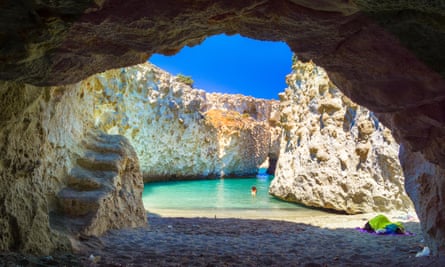
Greece’s second most notable volcanic island after glitzy Santorini, Milos is half as busy and twice as beautiful. Its horseshoe of mineral-rich multicoloured rocks is peppered with swimming lagoons, quarry ruins and whitewashed fishing villages.
Most good food and accommodation is found between the northern harbours of Adamantas and Pollonia. Kostantakis, the island’s only winery, benefits from volcanic soil, and restaurant O! Hamos!, south-east of Adamantas, cooks with homegrown ingredients. If the Psatha family can’t grow it, breed it or produce it on their farm, it has no business being on their hand-thrown plates.
Milos’s northern seaboard has a wonky charm, with its array of colourful syrmatas – traditional, white-washed fishermen’s cottages. Mandrakia is postcard pretty, with bobbing boats and some of the island’s best seafood at the seafront Medusa restaurant. A stay in a syrmata offers full immersion in maritime Milos. At Fisherman’s Syrma House (sleeps two, from €139 a night), west of Pollonia, the sea is the front garden.
Sarakiniko beach is a must-visit, a moonscape of rocks riddled with old tunnels, jumping nooks and even a shipwreck. Papafragas caves provide a similar experience of arches, caves and pools sculpted from the white rock. And the basalt columns of the Glaronisia islets, accessible by boat, are extraordinary.
Southern Milos is rich in mineral-mining history, which began about 7,000BC with obsidian quarrying. At Thiorichia beach, the buildings, shafts and rusting machinery of an abandoned sulphur mine sprawl up the hillside. Further west, the tiny golden carpet of Tsigrado beach and its cave-pocked cliffs are accessible by a wooden ladder. The dunes of nearby Gerakas beach can be visited by boat.
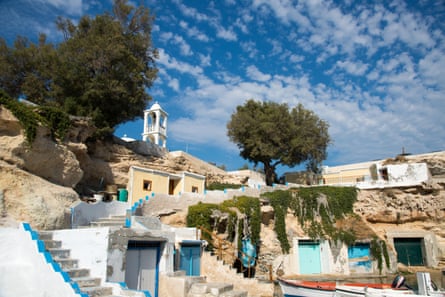
Western Milos is a largely uninhabited, protected Natura 2000 site, with some of Greece’s most memorable swimming. The sparkling sea caves at Kleftiko, in the south-west, are unforgettable. The name derives from the Greek for “thief”, and legend says one of the caves harbours pirate treasure. Sikia cave feels even wilder, its huge roof collapsed into a divine pool with a small beach, and nearby Saint Ioannis beach is a fine place for a peaceful sunset. Embourios Taverna, facing Adamantas across the natural harbour, is a waterfront locals’ hangout specialising in slow-cooked goat from the farm out back.
This is an edited extract from Wild Guide Greece by Sam Firman and Nick Hooton, published by Wild Things Publishing (£18.99). To buy a copy for £16.71 go to guardianbookshop.com
 Top Naija News: Nigerian News, Breaking News Nigeria and World News Top Naija News is a daily news publication in Nigeria, delivering the latest breaking news in Nigeria and around the world.
Top Naija News: Nigerian News, Breaking News Nigeria and World News Top Naija News is a daily news publication in Nigeria, delivering the latest breaking news in Nigeria and around the world.
